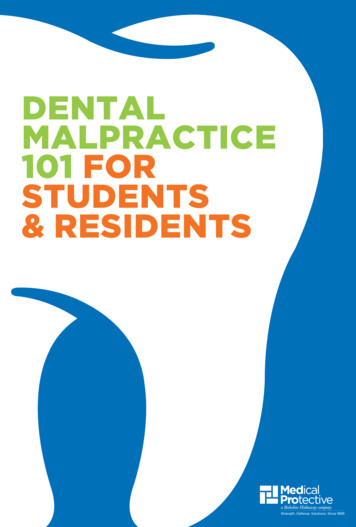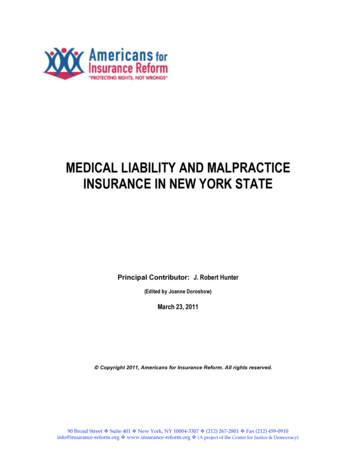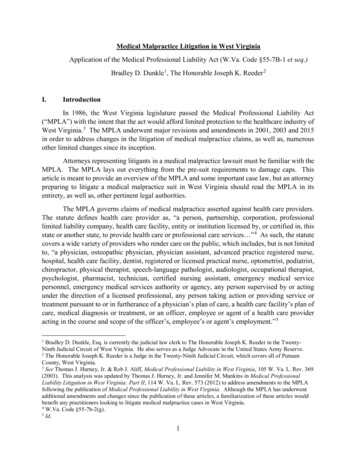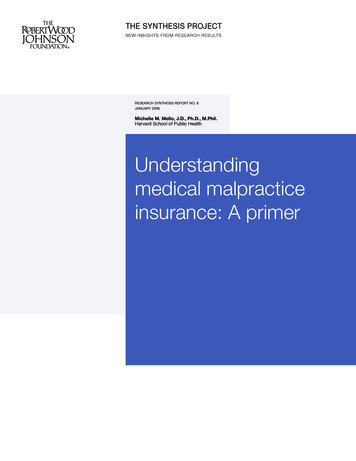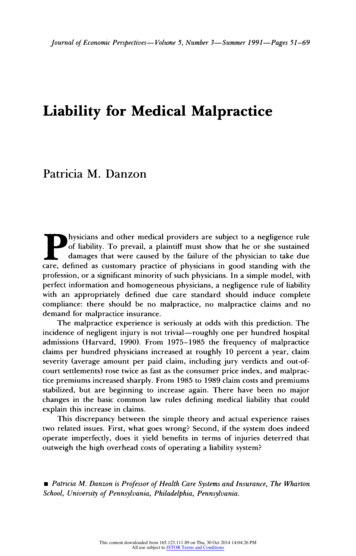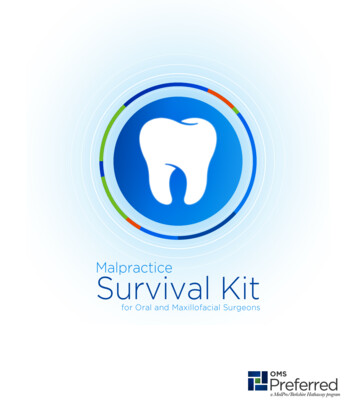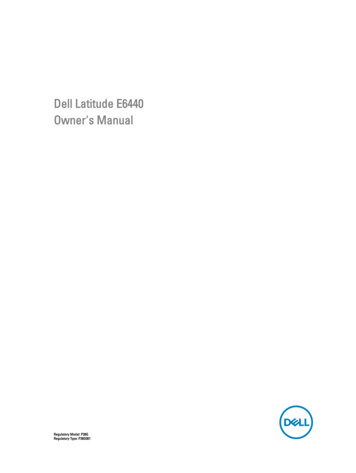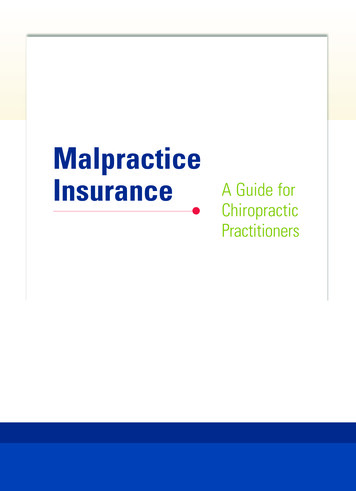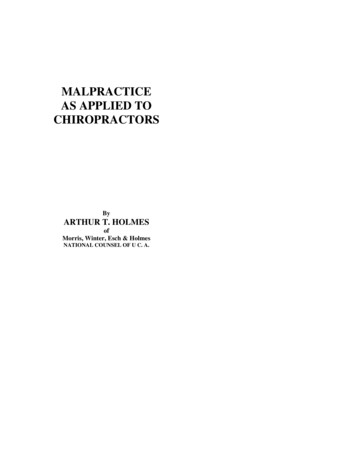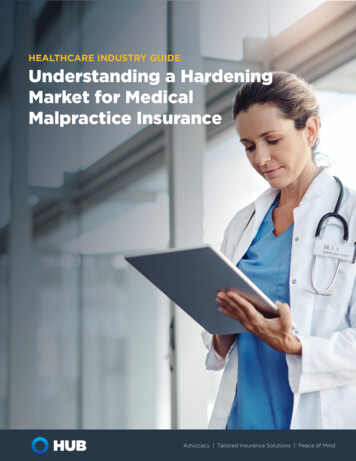
Transcription
HEALTHCARE INDUSTRY GUIDEUnderstanding a HardeningMarket for MedicalMalpractice InsuranceAdvocacy Tailored Insurance Solutions Peace of Mind
The 205 million medical malpractice judgment against theJohns Hopkins Bayview Medical Center in 2019 grabbedheadlines. The lawsuit concerned a child born in 2014after allegedly being deemed non-viable and inadequatelymonitored during birth. Deprived of oxygen, she was left withcerebral palsy that requires 24/7 care.1The case set a new record among the high dollar claims thatare plaguing healthcare providers and insurers alike. They areoccurring with alarming frequency and are a struggle for evenbeacons of quality care like Johns Hopkins to manage. It alsoillustrated a major factor behind the hardening market formedical malpractice insurance that’s expected to progressivelyworsen – with some predicting a doubling of premiums by theend of 2027.In fact, premiums are rising in many lines of insurancecoverage, and not just for the healthcare industry. But thetrend in medical professional liability (MPL) insurance follows14 years of a soft market despite increasingly high dollarjudgements. And many of the trends influencing MPL areaffecting other lines. In many cases, premiums are increasingand fewer insurance carriers are willing to offer coverage forproperty, directors and officers (D&O) and auto insurance,for example.A hard insurance marketdevelops as pricingfor coverage fails toadequately compensatefor high-cost claims. Itcauses underwriters totoughen their standards,reduce the amount ofcoverage they write, andprice it higher.It all calls for healthcare organizations to apply more surgicalprecision than ever before to their risk management d-to-maryland-woman/Understanding a Hardening Market for Medical Malpractice Insurance 2
Anatomy of a Hard MarketUnder PressureThe hard market in medical professional liability is drivenby the convergence of trends:ȋConsolidation and the changing profile of the healthcare delivery system.As rules governing mergers have relaxed, many hospitals have become bighealthcare systems, private practices come together as super groups, and manyonce-independent practitioners (44% of them, in fact2) are now employed byhospitals and hospital systems. As the provider community has shrunk, so hasinsurers’ underwriting volume.ȋConflict between productivity goals and delivering high-touch care.The pressures of trying to deliver quality care while satisfying the bottom linehave caused 42% of physicians to burn out and 15% of them to suffer fromdepression.3 Improved technology has offered new, but not risk-free efficiencies.It’s all combined to increase the exposure to malpractice claims.ȋMore severe claims, more often filed. Since 2015, high cost claims have grownin frequency and the number surpassing 10 million has jumped by 125%. In 2015,“only” 26 claims surpassed 10 million. By 2018, that had grown to 45.4 And thanksto social inflation, or the shift in societal attitudes towards claims, these claims willkeep rising in costs.Number of Medical Malpractice Claims Costing More Than 10M392620154531201620172018ȋFewer MPL insurers. Many alternative insurers (like captives and risk retentiongroups) have failed or exited the business. Others, like two well-establishedproperty and casualty firms and a large, state-sponsored carrier, have also gottenout. That’s less competition for the business that’s out there, a common rationalein any business to raise prices.ȋDecreasing underwriter profitability. Eight of 22 MPL insurers had negativeprofitability on their MPL policies in 2019’s fourth quarter. While many insurers stillhave large reserve surpluses from which to pay claims, they still need to maintainprofits and keep these surpluses n-Employment-Trends-Study2018-Update.pdf?ver igerRisk Partners, “MPL State of the Market – November.”Understanding a Hardening Market for Medical Malpractice Insurance 3
How a Hard Market PlaysDuring a PandemicAll the normal concerns raised by a hardening insurance market –from rising premiums to lower limits and changing terms – becomesecondary issues (at best) as our healthcare system battles COVID-19.The financial impact of the pandemic crisis for hospitals and healthsystems is being felt across the board, especially as profitable electiveprocedures have been cancelled to care for coronavirus patients.Meanwhile, though, providers are being battered by rising costs, suchas temporary staffing at higher crisis pay rates and for protectiveequipment and supplies like ventilators.The longer term fallout will likely be especially severe for the alreadythreatened rural hospitals, and hundreds may be forced to shutterbefore the crisis ends5. Many non-profits had slim or negativeoperating margins before the crisis and little cash on hand; the smallerorganizations will be particularly challenged to emerge whole. FederalCOVID-19 relief funding will make a critical difference6.For now, one frequent question is whether COVID-19-related losses arecovered by business interruption insurance, and the answer is mostlikely going to be no. That line of coverage is triggered by damageto real or personal property. A more troubling concern for the longerterm is the skyrocketing liability risk doctors and nurses on the frontlines have faced as they have been forced to ration care and performunfamiliar jobs because of staff and equipment shortages in a crisissituation. That’s something to be closely monitored, for -hospitalsUnderstanding a Hardening Market for Medical Malpractice Insurance 4
Twists and Turns inMalpractice ClaimsAround thirty states have caps on malpractice that, as of January,at least, have withstood constitutional challenges. Some cap noneconomic damages. Others have a hard cap on all damages. Plaintiff’slawyers have been able to maneuver around caps either way.For example, California’s cap of 250,000 on non-economic damagesfor medical malpractice (e.g. battery) claims does not apply toprofessional negligence (a difference of intent). It’s given rise to“hybrid” claims. In the fall of 2019, a jury heard the case of a man whohad much of his penis removed during a procedure to remove a massfrom his scrotum. The mass had spread and would affect his urethralfunction. But the man’s wife was not asked before the procedurewas changed to address this issue. The award: 22,000 in economicdamages and 9.25 million in non-economic damages.D&O Rates Rise with Issueslike Anti-Trust lawsuitsAs healthcare systems get larger, accusations of anti-competitivebehaviors step up, leading to antitrust lawsuits and separate claimsagainst the system’s directors and officers.It’s an area of growing concern to D&O insurers after settlementsin the last two years by big systems like Sutter Health in northernCalifornia, CHI Franciscan in Washington state, and Atrium Healthin North Carolina. The initial action against Sutter was by 1,500 selffunded health plans6 that accused it of charging 70% more for inpatientprocedures in northern California than in southern California. Suttersettled in November of 2019 for 575 e-65780916Understanding a Hardening Market for Medical Malpractice Insurance 5
Expect the Unexpected at Renewal for MPLAs these trends deepen, premium increases will be the norm in MPL.The severity of these increases will depend on past claims experience– the fewer extraordinary losses, the better. A demonstrable adherenceto a rigorous risk management plan makes a difference, too. HUBInternational’s healthcare practice members are currently projectingrates to increase by up to 10% for hospitals and large practice groups.But each case plays out differently.For one large medical group client with a premium of over 3.5 million,HUB’s detailed submission to five carriers included a loss analysis andtarget premiums. They came back with proposed premium increasesthat ranged from 10% to 112%, and coverage reductions but no limitincrease. The incumbent’s eventual package, a flat rate renewal withcoverages restored, won the day.Sometimes we’re surprised. HUB’s team told one hospital client toexpect a 10% increase at renewal which didn’t, in fact, occur. Instead,the insurer halved the client’s 20 million limit in excess coverage keptas a protection against high dollar claims. (It comes into play whenclaims covered by the primary policy are exhausted, another factor inmega-verdicts.).and other lines are cause for concern, tooAccelerating losses, shrinking capacity and other issues that areinfluencing medical malpractice are playing out in other lines for thehealthcare market, too. Property lines are pressured from the unremittingclaims costs related to hurricanes, tornadoes, floods and fires. Directorsand Officers (D&O) and employment practices liability (EPL) are facingchallenges, too, as senior level decision-making in healthcare systemscomes under fire, sparking claims with high settlements and high defenseexpenses that keep pushing rates up. Another hot spot is auto coverage,necessary not just for ambulances but also for transporting the aged orindividuals with mobility issues.Understanding a Hardening Market for Medical Malpractice Insurance 6
RATE INCREASE PROJECTIONSLine of BusinessHospitalsLarge Practice GroupsMedical Professional/ GL 0 - 10% 0 - 10%D&O/EPL 10 - 15% 10%Workers’ Compensation-5% - 0%-5% - 0%Automobile 10 - 15% 5 - 10%Property 15 - 20% 5 - 10%Cyber 0 - 5% 0 - 5%Aviation Helipad0%0%Pollution/Environmental 0 - 5% 0 - 5%NOTES:ȋ HUB projections are based off presumed risks with favorable loss experiencein favorable jurisdictions from a litigation standpoint.ȋ Some increases can be offset with higher retentions/deductiblesȋ The impact of COVID-19 may affect these projectionsȋProperty caveats: Larger increases in areas prone to events such as hurricanes, windand hail, and wildfires.ȋ Auto caveats: Much higher (15% - 20% increase) There is also a much higher increaseif patient transport is involved.ȋ Projections: Obtained from HUB credentialed Healthcare Specialty Experts inCalifornia; Massachusetts; Connecticut; Maine; Iowa; Illinois; Kansas City; Texas;Colorado; South Carolina.Understanding a Hardening Market for Medical Malpractice Insurance 7
How to Manage Your Risk Moving ForwardNow is the time to ensure you are following best risk management practices inyour policies and procedures. Start with a thorough risk assessment, lendinga particularly critical eye to the two troublesome areas of credentialing andelectronic medical management. Also understand the importance of the rightbroker partnership for tough times ahead. Here are key starting points.Risk Assessments Can Identify ProblemsBefore They HappenSurprisingly enough, nearly 70% of physicians have never undertaken a riskassessment7 even though it can make a difference in their medical malpracticerates. Important areas to evaluate include:7ȋLoss history. Long-term loss and incident data can reveal breakdowns in or needs fornew policies and procedures. Finite data provides a more precise view of departmentsin a hospital system or large practice groups that require a closer look.ȋProcedural review policies. These guard against errors like wrong-side surgeries.Detailed checklists, thoughtfully developed and consistently used, will reduce negativeoutcomes and lessen liability.ȋProcesses for managing hospital patients outside of surgery. This includes how patientsare informed about post-surgical costs, like physical therapy. Getting hit with unexpectedand unexplained costs leads to more malpractice claims, studies show. And hospitalists— doctors who specialize in hospital patients – are important for responding quickly topost-surgery emergencies. They communicate immediately and directly with the primaryphysician and handle issues quickly, thereby reducing malpractice claims.ȋClaims-handling, pre- and post-lawsuit. Mistakes are made. It’s best thing to step upand try to resolve them favorably with the patient. People are less likely to sue a medicalprofessional with whom they’ve established a good relationship. Apologizing may make adifference, but only if you are in a “sorry” state that has legislated that it can’t be consideredan admission of guilt. (And if doing so won’t jeopardize your professional liability policy.)ȋCharting and documentation. Quality assurance and efficient claims processing dependon good charting and documentation practices. Listing medical procedures proves theywere done. It also is a counter to patients who don’t follow advice or come back with thesame complaint without improvement.ȋEMR management. Electronic medical records (EMR) are a boon but also a big malpracticerisk when the cut and paste function is misused. Policies around its use should be reviewedto cut back on risks. Set ground rules and communicate on when and how to use thefunction. Using a voice-activated dictation system with your EMR system can also help.Also, audit it manually on a regular basis to insure you are on top of issues.https://www.medpro.com/Understanding a Hardening Market for Medical Malpractice Insurance 8
Credentialing Done Right HelpsHead Off ClaimsCase StudyCredentialing procedures also are an important aspect of yourrisk assessment and management over time. Sloppy practices meanmedical professionals with poor malpractice track records can slipin under the radar and cause big claims problems. Your proceduresshould include:ȋVerify all the details. There’s more to credentialing than checking on educationalbackground. The verification process should evaluate the practitioner’s completerecords, including loss history. A surgeon will have more of one than an internist,but a two-page loss run in either signals a problem.ȋBe aware of referral circumstances. Not all referrals are necessarily good. Take,for instance, a university whose board members or professors periodically proposedtheir physician golf buddies to the medical school staff. Although it may be politicallyuncomfortable if candidates’ claims histories aren’t up to snuff, it is still important toevaluate every medical professional’s record thoroughlyȋLook for red flags. Frequent moves from one hospital or practice to another areconcern. Plus, certain specialties are more prone to substance abuse which mighttrigger medical malpractice cases. Check for license suspensions by the medicalboard for such issues; they’re public record.Understanding a Hardening Market for Medical Malpractice Insurance 9
Your Insurance Broker Is Your Partner —How You Can Meet in the MiddleYou don’t have time to become an insurance industry expert.That’s why you need an experienced insurance broker. Look for ahealthcare industry specialist who ideally specializes in hospital andmedical practices and knows how to help you plan for renewals andadvocate on your behalf with insurance companies. Here are sixways to make the most of the relationship:1.Have regular meetings. Begin planning for your next renewal at least 120 days inadvance. But also engage in regular reviews of your losses year-round. The betteryour broker understands them, the better equipped he or she is to negotiate atrenewal.2.Establish a relationship with your insurer, too. A good insurance broker will fosterlong-term relationships between his clients and insurance companies. The betterthey know each other, the better they’ll respond to negative news. Insurers arewilling to reward accounts that remain loyal versus those who shop every renewalfor the lowest price. Longer-term relationships make for better business all around.3.Take on more of your own risk. Consider shouldering more of your own risk andtaking it off the insurance company as a way to reduce your premium. Your brokercan restructure your insurance program by reviewing account limits and replacingfirst-dollar coverage with deductibles and retentions. Sharing risk with yourinsurers sends a strong signal that you are serious about actively managing yourloss exposure.4.Know your numbers and tell your story. Be proactive. Tell your broker and insurerwhat you’re doing to prevent future losses. Make sure you are familiar with yourlarge losses ( 100,000 ) and loss trends so you can demonstrate to the carrier thatyou understand their root causes.5.Best terms require best information. When applying for or renewing coverage onyour behalf, your insurance broker needs to develop a high quality submission withdetailed information. If you have had a large loss, it must be well-researched andexplained in the most positive light possible. Every detail counts in today’s hardmarket.6.Seek Alternative Markets. If your broker hasn’t suggested it, ask about the benefitsof a captive or risk retention group for your medical professional liability coverage.Understanding a Hardening Market for Medical Malpractice Insurance 10
CHECKLISTChoosing the Right Insurance BrokerYou want to get advice from people who understand your business andknow your industry, and that includes your insurance broker. Before choosingone, ask these important questions. How long have you been involved in the healthcare industry?You don’t want to be the first. Your business is risky enough. What percentage of your book are clients like me?Confirm that your broker spends most of his or her time in your industry andunderstands trends and issues that could impact your business. How many insurance carriers can you bring to the table?Not all brokers have access to specialty insurance companies who serve the healthcareindustry. A brokerage firm that is in good standing with top-rated carriers has the bestchance of securing optimal coverage and pricing for your business. In addition to insurance, what expertise and services do you offer?Your broker should have clinical risk management capabilities, and should be ableto advise you on patient safety, staff training, and other healthcare risk managementstrategies. Can the broker review your contracts and advise you on risk exposures?Experienced brokers will review insurance clauses in all contracts and advise you onchanges you should make – at no additional charge. They should direct you to attorneyswho know your business and can review your other business contracts for liabilityexposures. What experience does the broker’s staff have when it comes to claims?When you file a claim, both your broker and your account management team should becommitted to advocating on your behalf with the insurance carrier. What other services or expertise can the broker offer?Ask for an introduction to your broker’s counterparts in employee benefits consulting.There are so many new ways to support your workforce and you need a specialist toadvise you on benefits.Understanding a Hardening Market for Medical Malpractice Insurance 11
Strategic support thatputs you in controlWhen you partner with us, you’re at the center of a vastnetwork of experts who will help you reach your goals. WithHUB, you have peace of mind that what matters most toyou will be protected — through unrelenting advocacy andtailored solutions that put you in control.For more information on how to manage your insurancecosts, reduce your risk and take care of your patients andemployees, contact a HUB healthcare insurance specialist.hubhealthcare.comAdvocacy Tailored Insurance Solutions Peace of MindThis information is provided for general information purposes only. HUB International makes no warranties, express, implied orstatutory, as to the adequacy, timeliness, completeness or accuracy of information in this document. This document does notconstitute advice and does not create a broker-client relationship. Please consult a HUB International advisor about your specificneeds before taking any action. Statements concerning legal matters should be understood to be general observations andshould not be relied upon as legal advice, which we are not authorized to provide. 2020 HUB International Limited. All rights reserved
Understanding a Hardening Market for Medical Malpractice Insurance 2 The 205 million medical malpractice judgment against the Johns Hopkins Bayview Medical Center in 2019 grabbed

